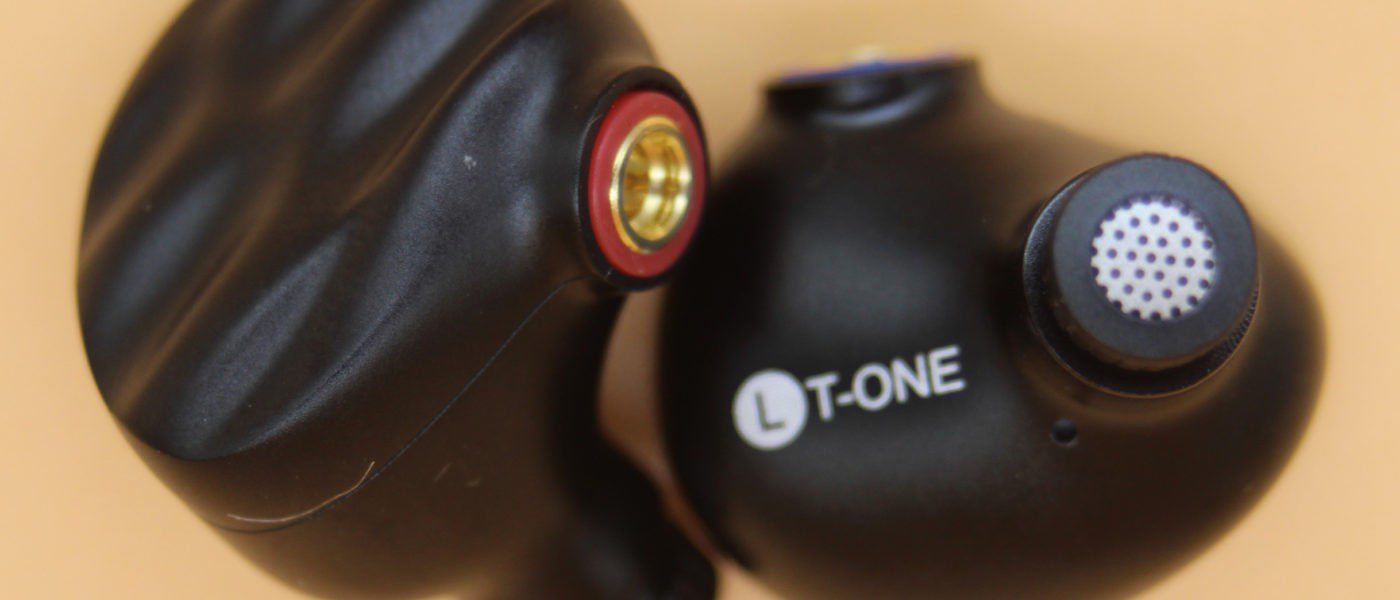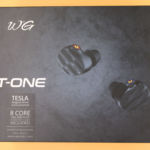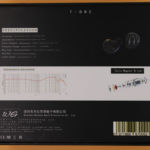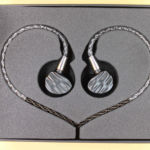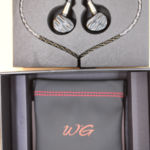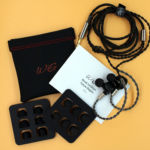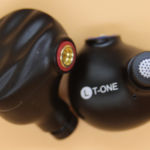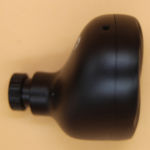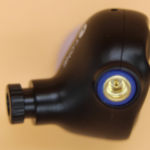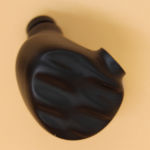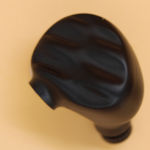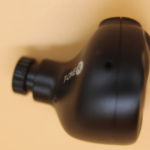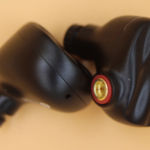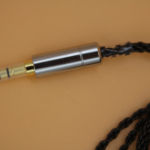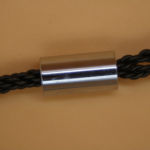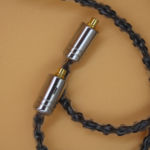W+G T-One
disclaimer: The W+G T-One was provided by Linsoul Audio for the purpose of this review. I have no financial interest in either Linsoul or W+G and have received no compensation for this review. Best I can tell, the W+G T-One is a Linsoul exclusive at present as the only shops that are advertising it are Linsoul and their Aliexpress Store.
Unboxing / Packaging:
The T-One comes tastefully boxed in a lift-top design with the Name and some marketing details on front along with pictures of the earpieces and the bulk of the details on the reverse. Lifting the top reveals the earpieces and cable in a heart shape in a foam surround with the remainder of the cable and other accessories hidden beneath. The Kit contains a soft case, 6 sets of tips on 2 cards, the earpieces, cable, and warranty card. The only let down here is the case which is a bit spartan for a model in this price range, otherwise the cable is of good quality and the tip selection is ample.
Build/Fit:
Shells are a two part design with a seam visible between faceplate and inner portions. Both are CNC machined aluminum with anodizing available in black, gray, and green so durability shouldn’t be a great concern depending on thickness of anodizing and how roughly the earpieces are treated. Faceplates have a rippled or wave pattern on the surface, while inner shells are polished smooth with rounded surfaces throughout. Shells are on the small side and are longer than tall with the nozzle exiting the top front. Nozzles have a slight upward rake and a pronounced lip for holding tips in place and allow for fairly deep insertion. I found isolation to be only average due in part to the small size of the shell and in part to a large vent at the rear. The vent is nearly directly in line with the label on the inner shell and sits on the fold between inner surface and faceplate. MMCX connectors are very slightly raised but well fitted with no gaps or glue visible.
I found comfort to be quite good for extended wear due to a lack of weight, small size, and tip-up style wear and think most should have little trouble with fit as these are among the smaller of the teardrop shaped models.
Internals:
The T-One uses a high magnetic flux 10.2mm dynamic driver with what it lists as a double layer composite diaphragm. It stops short of telling us the materials used, but does mention that the design was meant to reduce distortion and increase low frequency elasticity. The driver is made with both front and rear chambers specifically tuned so the shell is essentially eliminated from the tuning as the driver operates as a sealed unit. Nominal impedance is listed as 36Ω with a sensitivity of 105 dB/mW. This is borderline impedance for low powered sources, but the the high sensitivity does a good job of compensating for it and while I found it did scale well with higher powered sources, I didn’t feel that I was missing anything when run directly from a smart phone or tablet.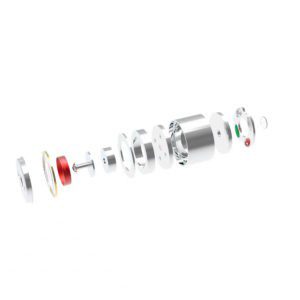
Cable:
The provided cable is listed as 24 strand silver plated oxygen free copper. At the south end, the jack is straight with a polished metal housing and no strain relief before the 8 wire twist exits to the north. The splitter is barrel matching the jack housing and again no strain reliefs are present on either side. Cables exit as two 4 wire twists with no chin slider or mic on the upper length. The north ends terminate in pre-formed hooks with mmcx connectors in matching polished metal housings. The housings have L/R clearly labeled as do the inner shells of the earpiece so alignment is straight forward. I applaud this as all too often one, the other, or both parts lack proper labeling.
Sound:
Bass:
Sub-bass extension is fairly good with roll-off only becoming evident in the upper 30s. This is not a class leader, but not too far behind them either as most struggle to get much below the mid-30s cleanly. Sub-bass quantity is elevated above the baseline, but not so much as to dominate the landscape. Moving into the mid-bass, a slow decline in level keeps the mid-bass from stepping out in front of other elements. Attack is slightly blunted with decay being a hair slower yet. This keeps the T-One from sounding aggressive at the upper end, but does limit the overall texture of the bass. This was something that could be heard in walking bass-lines as the runs became a bit more fluid and individual tones less clear at times. Overall, a balanced, smooth bass effort with just enough bleed to warm up the sound, but not interfere with detail of the mids, if a bit smoothed over and less resolving as a result of the tuning.
Mids:
Lower mids carry a bit of extra energy as the bottom of the V is right smack at the midpoint of the signature with both lower and upper mids climbing from that midpoint. On the lower side, a hint of bass bleed brings some warmth and a good thickness to the sound. This gives the viola a nice texture and acoustic guitar as well. Lower register vocals have good tone and do cut through the rest of the instrumentation, but are a step behind their upper counterparts due to a bit stronger push on the upper mid side of the V. Female vocals are nicely forward, but are not in your face. Details in the mid range are a bit cleaner than the bass and strings are believable if not as detailed as possible. Again we see trade offs made for balance and smoothness at the cost of transients and textures.
Treble:
We see more of the same pattern in the treble. Lower treble starts with a bit of extra energy but falls back quickly enough to avoid getting strident. The bulk of the T-One’s treble is below 7kHz which limits the top end sparkle a bit but it does have some energy brought back between 10kHz and about 12kHz where final roll-off becomes evident, that helps keep snare rattle and high-hat from sounding unnatural. I classify the treble as mildly elevated early and polite in the overall. Again we see good balance and some smoothing in exchange for transients and detail.
Soundstage / Imaging:
Sound stage has good proportion in both width and depth with some sense of height. If anything, the stage seems a bit deeper than wide which is a nice departure from the far more common width > depth arrangement. Instrument separation is good, but does break down a bit on exceptionally busy passages. This is hardly a knock at this price point, but is worth noting if speed metal is on your “to do” list. Seating the orchestra is fairly straight forward with no major overlaps or errors. Imaging is a bit less precise than some others in the class and while a general sense of directionality is certainly present, pinpointing a sound in space is a bit less so. In this regard, the T-One is probably fine for listening as none of the placements are outright incorrect, they just lack the precision of some other competitors that might be better for gaming or cinema use as a result.
Comparisons:
With lots of newly released single dynamic driver models in the roughly $100 USD price class, I decided to use those as the basis of comparison as they are all vying for your dollar.
Tin Hifi T4
The Tin Hifi T series has been around awhile now, and the latest release the T4 follows a fairly familiar pattern. Barrel shaped housing, mmcx connector, 10mm dynamic under the hood and a price point of right at $100. Many will have a preference for one style or the other, but for me fit was roughly equal with neither being particularly physically fatiguing. Tuning wise, the T-One has a little more V to its shape, but that helps balance what can seem like an overly bright treble on the T4 due to its lighter bass footprint. The treble shy have always struggled a bit with Tin Hifi tunings and will likely prefer the T-One as a result. The T4 may offer slightly more detail than the T-One but how much of that difference is actually due to a brighter treble and how much is truly detail retrieval can be difficult to sort out.
KBear Diamond
The diamond adopts a shape closer to the T-One than our previous contestant, but is built like a tank when put side by side with the T-One. The diamond seems overbuilt and a bit clunky compared to the finesse of the T-One and in the looks department the T-One is the clear winner in my thinking. Cables are of roughly equal quality although I might give the diamond a slight edge in this category. Sound wise the two are very similar with both opting to sacrifice a bit of detail for a smooth signature. Neither is going to be the best choice for an analytical listen as both are more tuned for long casual listening sessions. Stage is slightly larger to my ear on the T-One when compared to the diamond, but not by enough of a margin to declare it an easy victory. With all the similarities, I think it will likely come down to aesthetics and fit between these two and for me that favors the T-One.
Moondrop Starfield
Yet another similar model is size, shape, driver, and price range. The Starfield is a bit prettier, while the T-One settles for a subdued rippled black shell, but the T-One is a bit more rounded off and slightly thinner so may be an easier fit for small ears. I’d also give the T-One points for an improved cable compared to that provided with the Starfield. Had the T-One been released before the Starfield, Diamond and T4, it would have been an easy recommendation as it has a very similar tuning to the Starfield and Diamond and sits somewhere between the Diamond and T4 in treble. Those who have the T-One don’t need the others and vice versa, but it doesn’t do enough to separate itself to be a clear call and to me it lacks just a bit of detail and clarity of the Starfield. This one is a tough call, but the Starfield brings a little more detail retrieval and a slightly better low end extension.
Thoughts / Conclusion:
I am conflicted. On one hand, the WG T-One does a lot very well. It is polite, balanced, well built, and has the best cable of the lot I compared above. For those that prefer a smooth delivery, the T-One ranks right up there with the best of breed. My issue is that it creates a bit of that smoothness by obscuring a few of the details. I am a fan of planar and electrostats for their transient response and the detail level they afford and this is where the T-One loses just a bit of its shine. A couple years ago, this would have been an absolutely killer iem at the $100 mark. Today, its a crowded market and pretty much every musical taste can find something to their liking. Many will find the T-One a great companion, while others will be more pleased by one of its competitors. The differences between the T-One and many of the other single dynamics that have been released in the same price range of late, are more about preference than technical merits. For a smooth, balanced, polite in ear, the T-One deserves a good hard look.
-
Bass - 7/107/10
-
Mids - 7.5/107.5/10
-
Treble - 7/107/10
-
Soundstage - 7.5/107.5/10
-
Imaging - 7/107/10
Summary
Pros – Well made, better cable than many competitors, balanced signature
Cons – lacks a bit of detail retrieval compared to best in class.

